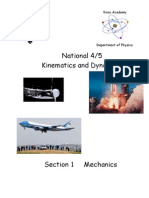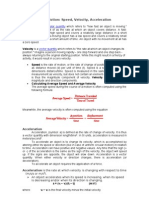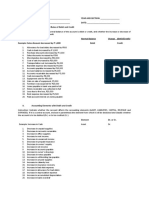Distance-Time Graphs (Section 3) - Extended Math
Uploaded by
novaDistance-Time Graphs (Section 3) - Extended Math
Uploaded by
nova"
Travel graphs:
distance–time graphs
A travel graph describes the motion of a
particular object. There are two types of travel
graph you need to be able to work with:
distance–time and speed–time graphs.
Distance–time graphs
Have a look at the following travel graph. It
shows how the distance (in kilometres) changes
as the time (in hours) changes. It is called a
distance – time graph .
" Study skills
A distance–time graph shows how the
distance of an object changes as the time
changes.
Make sure to carefully consider the units
of a distance–time graph.
When analysing the graph, you notice the
journey represented by the graph consists of
three parts (A, B and C). Let us calculate the
rate of change, or gradient, of part A:
y2 − y1 6−0
gradient = = =2
x2 − x1 3−0
So the gradient of part A is 2. What does this
gradient represent? Let us include the units to
find out.
6 km − 0 km 6 km
gradient = = = 2 km per hour.
3h−0h 3h
" Study skills
The gradient of a line on a distance–time
graph represents the speed of the object.
Now look at part B of the journey. As the time
increases from 3 to 5 hours, the distance
remains the same. In other words, the object is
standing still for 2 hours! The gradient of a
horizontal line is zero, therefore the speed of the
object is zero.
" Study skills
A horizontal line on a distance–time graph
represents a speed of zero (the object is
standing still, or is stationary ).
Finally look at part C of the journey. It is no
longer a horizontal line, so the object is moving
again. To calculate the speed, you need to find
the gradient of that line. Would you expect the
speed of part C to be greater, equal to or less
than the speed of part A?
10 − 6 4
gradient = = km per hour.
10 − 5 5
The gradient and therefore the speed of the
object during part C of the journey is less than
its speed during part A.
" Study skills
On a distance–time graph, the steeper the
line, the greater the gradient and therefore
the greater the speed.
Distance–time graphs often describe a real life
scenario.
Think of a story that is represented by this
distance–time graph.
Worked example 1
The distance–time graph shows the journey of a
car. Calculate both the greatest speed and the
average speed , in kilometres per hour, of the
car during the journey.
» Show solution
" Study skills
total distance travelled
Average speed =
total time taken
This includes the time when an object is
standing still!
This distance–time graph shows the motion of
an object in metres, over a 10 second period.
The journey can be divided into five parts.
During parts A and C, the object is travelling
with a constant speed in a forward direction.
During parts B and D, it is stationary (not
moving).
What is happening during part E? The line is
going down so the gradient must be negative.
Calculate the gradient of line E:
0−4 −4
gradient = = = −2 metres per second.
10 − 8 2
The distance when t = 10 is zero, so the object
is back where it started. So a negative speed
means motion in the negative direction.
" Study skills
For a distance–time graph:
A line with a positive gradient
represents an object moving away
from its origin.
A horizontal line represents an object
standing still.
A line with a negative gradient
represents an object moving back
towards its origin.
Worked example 2
This distance–time graph shows Jan cycling to
the library to drop off some books and then
cycling back home again.
a) Write down the distance between the library
and Jan’s home.
b) How long does Jan stay at the library?
c) Calculate the distance of the total journey.
d) Calculate the average speed of the total
journey in kilometres per hour.
» Show solution
Worked example 3
Kate lives 5 km away from school. One
morning she decides to walk to school. Kate
walks with a constant speed of
4 kilometres per hour . After walking for 30
minutes, she needs to wait for 10 minutes to
cross a junction. Once she has crossed the
junction, she continues walking at a constant
speed for another 40 minutes, after which she
reaches school. Construct a distance–time graph
showing Kate’s journey and calculate her
average speed.
» Show solution
" Study skills
When creating your own graph, make sure
it fits on your page but do not make it too
small. Look at the total time and distance
and use an appropriate scale.
! Hint
distance
speed =
time
distance = speed × time
distance
time =
speed
The triangle may help.
Worked example 4
Rebecca commutes from York to Leeds every
morning. She takes the train that departs at 7:00
and arrives at 8:12. Considering that the train
travels at an average speed of 37.5 kilometres
per hour, find the distance between the two
cities.
» Show solution
Section questions
! Complete this section with 4 questions
Start questions
! Previous section Next section "
" # # $ %
Overview Book Notebook Practice Assignments
You might also like
- Calculatingspeedtimedistanceandgraphingmotiondistancetimegraphs 167% (3)Calculatingspeedtimedistanceandgraphingmotiondistancetimegraphs 123 pages
- Thinking in Systems and Mental - Marcus P. Dawson100% (1)Thinking in Systems and Mental - Marcus P. Dawson306 pages
- Handbook of Sustainable Concrete and Industrial Waste ManagementNo ratings yetHandbook of Sustainable Concrete and Industrial Waste Management6 pages
- Distance-Time Graphs: This Graph Shows A Moving Object Moving Further Away From Its OriginNo ratings yetDistance-Time Graphs: This Graph Shows A Moving Object Moving Further Away From Its Origin9 pages
- 1544485978time Speed Distance PDF Ebook PDF100% (1)1544485978time Speed Distance PDF Ebook PDF54 pages
- National 4/5 Kinematics and Dynamics: Knox AcademyNo ratings yetNational 4/5 Kinematics and Dynamics: Knox Academy49 pages
- Motion - Distance Time Graphs and Speed Time GraphsNo ratings yetMotion - Distance Time Graphs and Speed Time Graphs31 pages
- Motion and Time: Check Your Progress Factual QuestionsNo ratings yetMotion and Time: Check Your Progress Factual Questions27 pages
- CH 1a Motion - Ticker Timers Notes 2024No ratings yetCH 1a Motion - Ticker Timers Notes 202427 pages
- Lecture Notes On Straight-Line Motion and GraphsNo ratings yetLecture Notes On Straight-Line Motion and Graphs7 pages
- Computation of Straight Motion Through Graphs Analysis: ReviewNo ratings yetComputation of Straight Motion Through Graphs Analysis: Review3 pages
- AP Physics B Notes - Kinematics in One Dimension100% (1)AP Physics B Notes - Kinematics in One Dimension8 pages
- Anton Paar Density Meter DMA 1001 Operation ManualNo ratings yetAnton Paar Density Meter DMA 1001 Operation Manual26 pages
- Multicast Part of The CCIE EI Workbook Orhan ErgunNo ratings yetMulticast Part of The CCIE EI Workbook Orhan Ergun32 pages
- 402 Vocational IX - (OpenOffice) Answer Key PART B100% (2)402 Vocational IX - (OpenOffice) Answer Key PART B31 pages
- Worksheet in Zoology Lecture Animal Biodiversity (Part 1) : CalcareaNo ratings yetWorksheet in Zoology Lecture Animal Biodiversity (Part 1) : Calcarea3 pages
- HDCP 2.3 On DisplayPort Comppliace Test Specification Mar 19No ratings yetHDCP 2.3 On DisplayPort Comppliace Test Specification Mar 19129 pages
- 01- 24 MLD STP Bijnor Power Consume Report January-2025No ratings yet01- 24 MLD STP Bijnor Power Consume Report January-20251 page
- 99.poultry Breeding and Multiplication Center OkNo ratings yet99.poultry Breeding and Multiplication Center Ok21 pages
- Bhaktivedanta_Vidyapitha_SB_Canto_10_OverviewNo ratings yetBhaktivedanta_Vidyapitha_SB_Canto_10_Overview208 pages
- Differential geometry of manifolds Second Edition Lovett 2024 scribd downloadNo ratings yetDifferential geometry of manifolds Second Edition Lovett 2024 scribd download55 pages

























































































